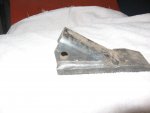I need some opinions, especially from you practical & career engineer types.
As an experiment, I took the worst worn bucket pin, and turned it to clean up.
Now, I can make custom bushings to fit the bored oversize ears on the bucket, and to fit the reduced diameter pins.
My question is:
Are the reduced diameter pins going to be too small? (I.E. weak, likely to bend?)
The nominal diameter was originally 1.181", reduced diameter is 1.088", a 7.8% reduction.
The new bushings will have a lot more bearing surface, as they were surprisingly short, and would be easy to lengthen.
The pins appear to be induction hardened in the load bearing area, and soft out where the cross bolt hole is. (see pics)
My B670 backhoe has 1.000" diameter mild steel pins, but it is a smaller machine.
2nd pic shows a black spot, approx .002" dp, that didn't clean up.
View attachment 84353
View attachment 84354
View attachment 84355







